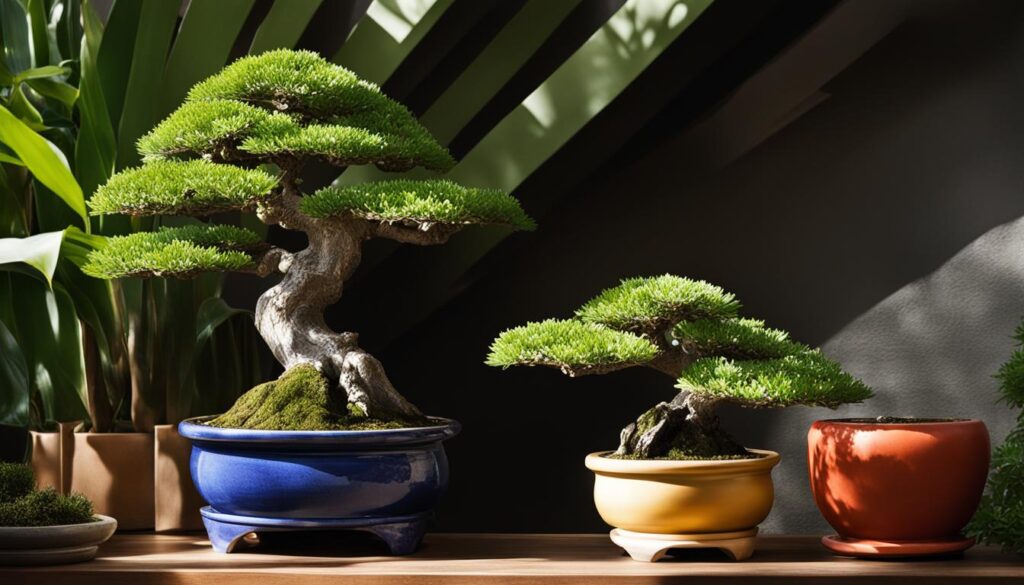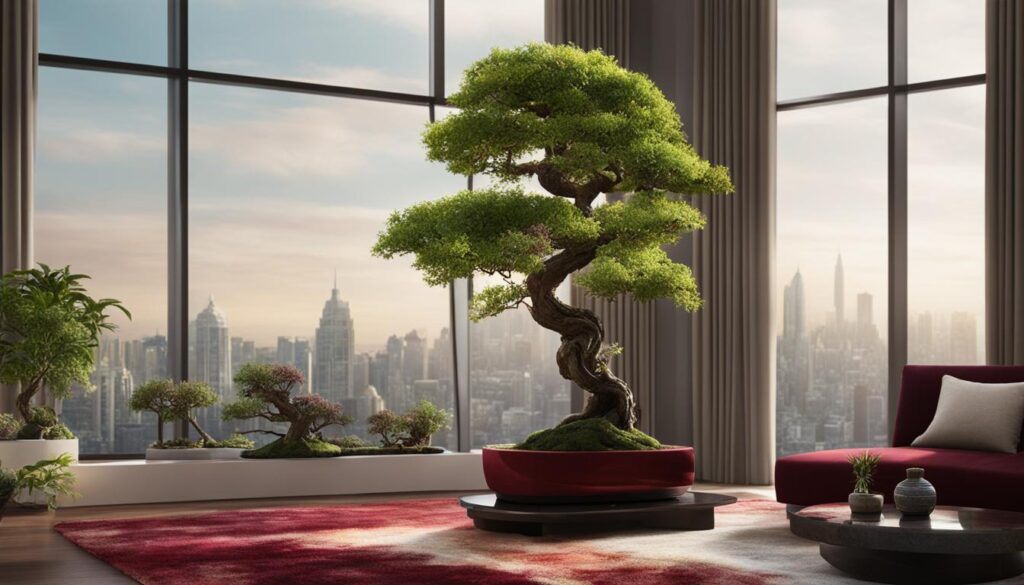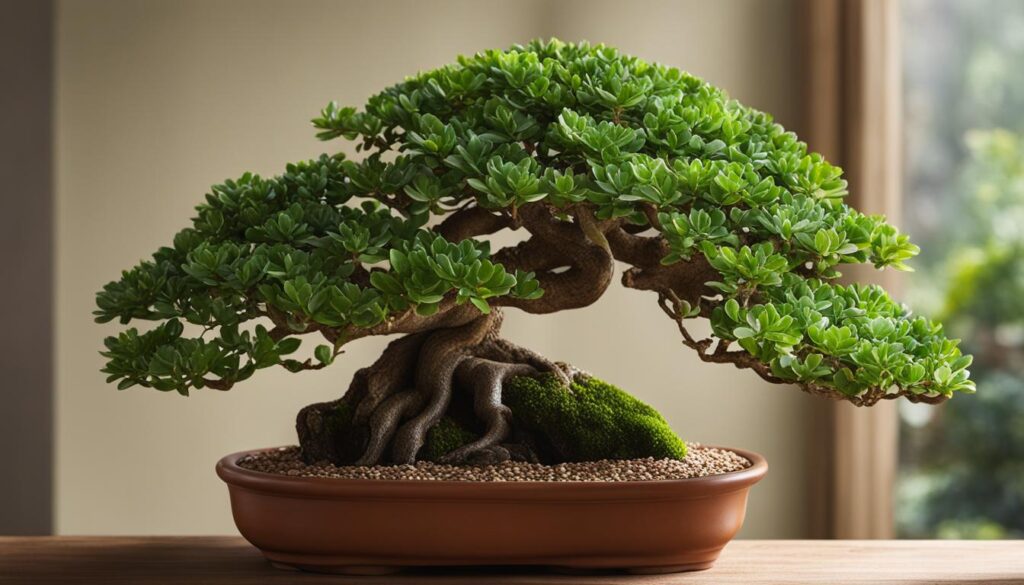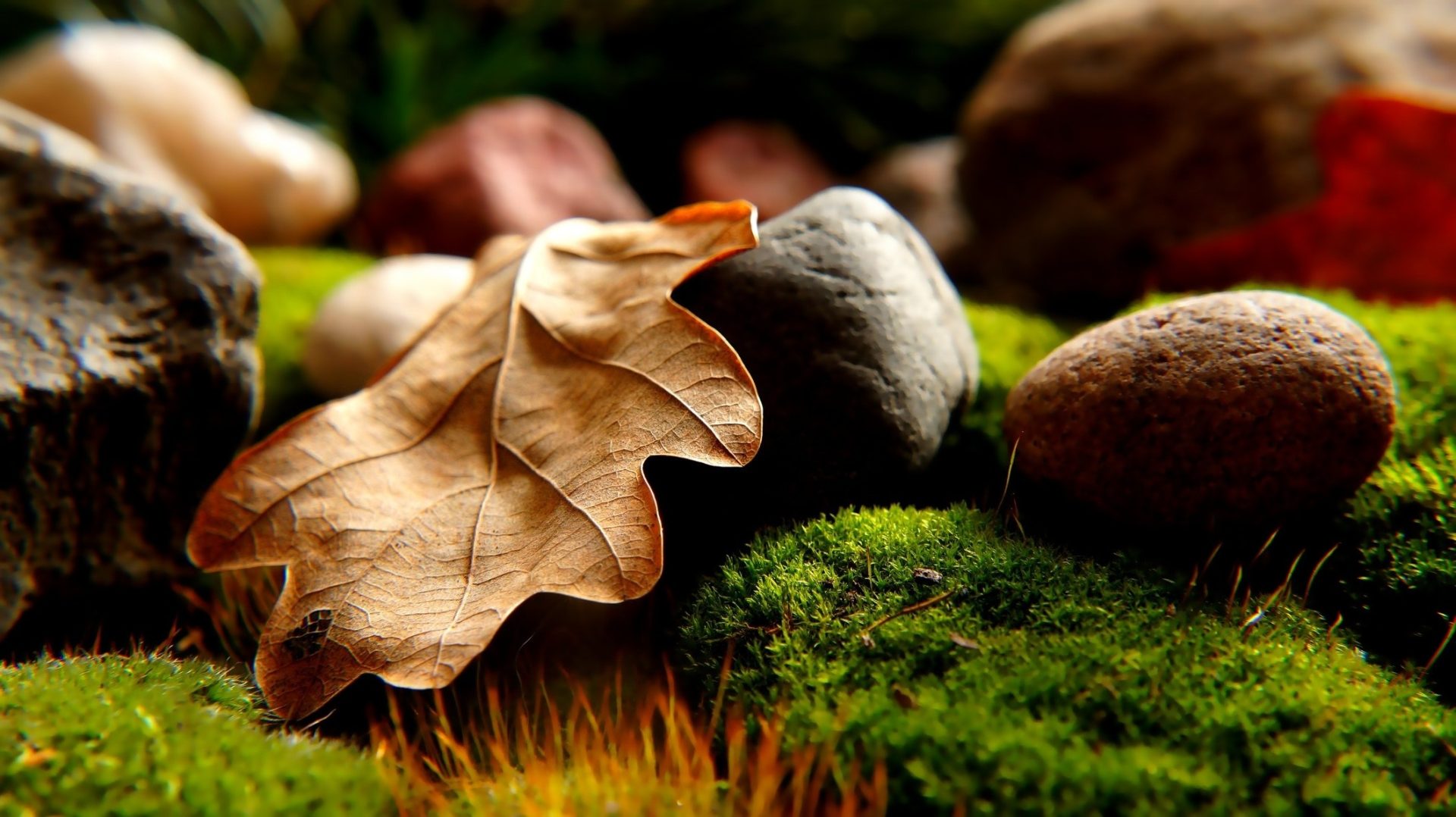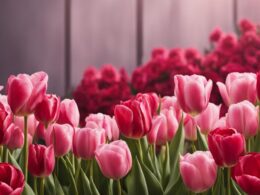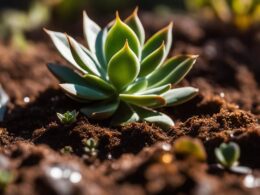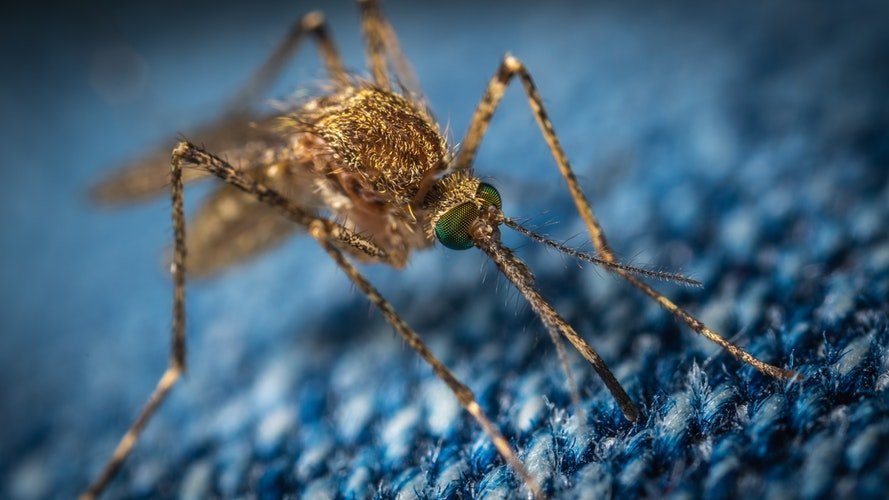With a myriad of indoor bonsai tree types to choose from, cultivating miniature trees can be a rewarding and delightful way to bring a touch of nature into your home. Bonsai varieties indoor can range from tropical to subtropical species, each providing unique aesthetics and care requirements. In this guide, you will learn about choosing bonsai trees suited for the indoor environment and how to best care for them.
Key Takeaways
- Indoor bonsai tree types include tropical and subtropical varieties that can adapt well to indoor environments.
- Choosing bonsai trees appropriate for indoor cultivation is essential for success, as not all species thrive indoors.
- Understanding the different care needs of indoor bonsai trees – such as light, humidity, and watering requirements – will help ensure their healthy growth.
- Indoor bonsai trees can bring beauty and tranquility to your living space when given proper care and attention.
- Exploring a wide variety of bonsai species will enrich your indoor bonsai collection and enhance your understanding of this intricate art form.
The Intricate Art of Bonsai: Indoor vs Outdoor Varieties
Understanding the differences between indoor and outdoor bonsai species is crucial for success in bonsai art and cultivation. While many bonsai species naturally flourish outdoors, certain tropical and subtropical varieties can thrive indoors if provided with adequate lighting and humidity.
Majority of bonsai species are better suited for outdoor settings, where they can experience natural sunlight and temperature fluctuations. However, some species can be grown indoors, particularly tropical and subtropical varieties. Choosing the right variety is essential, as temperate bonsai require dormancy periods facilitated by outdoor climates, unlike their tropical counterparts that thrive indoors all year round.
| Bonsai Types | Ideal Environment | Characteristics |
|---|---|---|
| Tropical Bonsai | Indoors | Adaptable to indoor conditions, can tolerate consistent lighting and humidity levels |
| Subtropical Bonsai | Indoors | Require slightly cooler temperatures but can still thrive within the boundaries of an indoor environment |
| Temperate Bonsai | Outdoors | Need specific outdoor conditions, such as dormancy periods facilitated by changing climates |
It is essential for beginners in bonsai art to identify the appropriate species for their preferred environment and understand the specific care requirements for successful bonsai cultivation.
- Tropical Bonsai: Species such as Ficus, Schefflera, and Carmona are well-suited for indoor environments due to their ability to adapt to consistent lighting and humidity levels.
- Subtropical Bonsai: While these species may require slightly cooler temperatures compared to tropical bonsai, they can still thrive indoors as long as they receive proper care in terms of lighting and humidity.
- Temperate Bonsai: These species necessitate specific outdoor conditions, including fluctuating temperatures and seasonal dormancy periods, to thrive and maintain their health.
In conclusion, selecting an appropriate bonsai species for your desired environment is a critical first step. By understanding the key differences between indoor vs outdoor bonsai, both beginners and experienced practitioners of bonsai art can ensure a successful and thriving bonsai cultivation experience.
Top Indoor Bonsai Trees for Beginners
When starting the journey of bonsai cultivation as a beginner, it’s essential to choose the right species that adapt well to indoor conditions. Ficus, Carmona, and Schefflera are three popular beginner bonsai trees known for their indoor compatibility and aesthetic values.
Ficus Bonsai: An Evergreen Choice
The Ficus bonsai, including the Ficus Benjamina and Ficus Retusa variants, is an excellent beginner choice due to its resilience. Recognized for its adaptability, the ficus bonsai can thrive even with low humidity and less light, making it a hardy option for indoor cultivation. It features vivid green leaves, and some ficus varieties can even produce flowers and fruit. A few top reasons for choosing Ficus bonsai as a beginner’s indoor tree are:
- Evergreen foliage maintains a fresh appearance year-round
- Adapts well to lower light conditions
- Resilient and sturdy, even in less-than-ideal environments
The Carmona Bonsai: Delicate Flowers Indoors
Carmona bonsai, also known as the Fukien Tea bonsai, is celebrated for its capability to blossom small white flowers throughout the year and red fruit, which adds to its aesthetic appeal indoors. While it prospers under strong light, owners are recommended to occasionally place it outside during warmer months. Some attractive qualities of the Carmona bonsai include:
- Indoor flowering bonsai providing year-round blossoms
- Dark green leaves with small, delicate flowers
- Oval-shaped canopy enhances the tree’s visual attractiveness
Schefflera Bonsai: The Easy-Care Dwarf Umbrella Tree
The Schefflera bonsai, known as the Dwarf Umbrella Tree, suits indoor conditions with its preference for low light and low humidity. Its distinctive thin trunks and canopy-like growth make it a visually interesting choice. However, if planning to shape and train the plant, take note that schefflera doesn’t respond well to wiring techniques. The table below highlights the unique characteristics of Schefflera bonsai:
| Attribute | Description |
|---|---|
| Name | Schefflera/Dwarf Umbrella Tree |
| Light requirements | Low light bonsai, can manage with minimum light levels |
| Humidity preferences | Low humidity, can tolerate dryer indoor climates |
| Training methods | Best suited for clip-and-grow techniques, doesn’t respond well to wiring |
| Main advantage | Easy-care bonsai, perfect for beginners starting with indoor trees |
Choosing the right species, such as Ficus, Carmona, or Schefflera bonsai, is essential for indoor bonsai enthusiasts. These beginner bonsai trees are not only compatible with indoor conditions but also grant year-round beauty to your living space.
Caring for Your Indoor Bonsai Tree
Indoor bonsai trees require special attention and care compared to regular houseplants. To ensure the health and longevity of your bonsai, it is essential to understand and properly address its lighting, humidity, and watering needs. Let’s explore these crucial aspects of indoor bonsai care.
Bonsai Lighting Needs
Providing sufficient light is critical to the growth and well-being of your indoor bonsai tree. Although some varieties can adapt to lower light conditions, most indoor bonsai thrive in bright, indirect sunlight. To supplement natural light, you can use artificial lighting systems such as fluorescent or LED growth lamps. Position your bonsai near a window that receives ample sunlight or within a few feet of the light source.
Bonsai Humidity Requirements
Tropical and subtropical bonsai trees, which are the primary candidates for indoor cultivation, have higher humidity requirements. You can maintain adequate humidity levels by using a humidity tray, which is a shallow dish filled with water and gravel on which you can place your bonsai pot. The water will evaporate and create a moist environment around your plant without causing the roots to become waterlogged.
Bonsai Watering Tips
Watering plays a pivotal role in nurturing the health of your indoor bonsai. Be aware that overwatering or underwatering can harm your bonsai, so it is better to water based on the dryness of the soil rather than sticking to a predetermined schedule. Use the following tips to manage your bonsai’s watering needs effectively:
- Check the soil’s moisture by gently poking your finger about an inch deep into the soil. If it feels dry or slightly moist, it’s time to water your bonsai.
- Water your bonsai thoroughly until water flows out of the drainage holes in the pot. This ensures that the root system is receiving sufficient moisture.
- Avoid wetting the foliage, as it can invite pests and diseases.
Maintaining Room Temperature
Your indoor bonsai tree will flourish in a steady room temperature, typically between 65-75°F (18-24°C). Keep your bonsai away from drafts, cold windows, or doors that might cause sudden fluctuations in temperature. Positioning your bonsai away from heating and air conditioning vents can prevent excessive drying of the foliage and soil.
By attending to your indoor bonsai tree’s lighting, humidity, and watering needs, you can nurture a healthy, thriving plant that adds natural beauty and serenity to your living space.
Dwarf Jade Bonsai: A Thick, Succulent Option
If you’re looking for a unique indoor bonsai option, consider the Dwarf Jade bonsai. This succulent bonsai showcases a thick trunk and fleshy leaves, creating an appealing visual aesthetic. Its sensitivity to cold temperatures makes it ideal for indoor cultivation.
One of the key features of the Dwarf Jade bonsai is its capability to store water in its leaves. This reduces the necessity for frequent watering, making it easier to care for compared to other bonsai varieties. However, to ensure the health of your Dwarf Jade bonsai, pay attention to the following care tips:
- Well-drained soil: Ensuring that your bonsai is planted in well-draining soil is critical for preventing root rot. This succulent bonsai prefers a soil mixture that is porous and allows excess water to be drained efficiently.
- Moisture meters: Utilizing a moisture meter will help you prevent overwatering, as Dwarf Jade bonsai are more susceptible to damage from excessive water than from drought.
- Adequate lighting: While this bonsai can tolerate lower light conditions than other indoor bonsai varieties, it still needs plenty of light to thrive. A bright, indirect sunlight location or supplemental lighting from LED or fluorescent grow lights can help meet these requirements.
- Temperature: Dwarf Jade bonsai should be kept in a warm environment, away from cold drafts or fluctuating temperatures. Ideal temperature range for this indoor bonsai is between 65 and 75°F (18 and 24°C).
Bonsai enthusiasts love the Dwarf Jade bonsai for its easy care requirements and distinctive appearance. By following these guidelines, you can enjoy the beauty of this succulent bonsai in your indoor living space.
Challenges in Growing Temperate Bonsai Trees Indoors
Attempting to grow temperate bonsai trees indoors poses numerous challenges due to the unique requirements of these species. Indoor environments often lack the necessary elements to facilitate optimal growth, affecting the dormancy period and light and temperature conditions.
The Importance of Dormancy for Bonsai Trees
Dormancy in bonsai trees is a critical aspect of their growth cycle. During the colder months, temperate bonsai trees enter a dormant state to conserve energy and prepare for new growth in the spring. This period of dormancy is difficult to replicate indoors, as it requires the complete absence of light, a significant drop in temperature, and a reduction in water and nutrient intake.
Temperate bonsai trees grown indoors may continue to exhibit new growth throughout the winter, leading to a weakened tree that struggles to survive in the long run. The absence of a dormant period can disrupt the natural growth cycle of bonsai trees, ultimately hindering their overall health and development.
Adapting to Indoor Light and Temperature Conditions
Another challenge in growing temperate bonsai indoors is matching the light and temperature conditions essential for their survival. Indoor environments tend to lack the same intense natural sunlight and temperature fluctuations experienced outdoors, making it challenging for temperate bonsai trees to thrive.
To create optimal indoor bonsai conditions, consider the following strategies:
- Position the bonsai in the brightest spot in your living space.
- Supplement natural light with artificial bonsai light, such as fluorescent or LED growth lamps.
- Maintain consistent room temperature for tropical bonsai varieties.
- Replicate cooler environments for subtropical types by placing them near a cool, draft-free window.
Despite these efforts, replicating the ideal conditions for temperate bonsai indoors is an arduous task due to the inherent differences between indoor and outdoor environments. Successful cultivation of temperate bonsai trees is more easily achieved outdoors, where they can experience the necessary dormancy period, lighting, and temperature fluctuations crucial for their growth and longevity.
Can Indoor Bonsai Trees be Grown from Seeds?
Yes, indoor bonsai trees can be grown from seeds. The process of growing bonsai tree seeds requires patience and dedication. With the right care and attention, bonsai trees can be cultivated from seeds indoors, allowing for a beautiful and unique addition to any indoor space.
Indoor Bonsai Tree Guide: Cultivating Success and Tranquility
Embarking on your indoor bonsai tree journey may be a daunting task, but by arming yourself with the knowledge and guidance provided in this article, you are on the path towards successful bonsai cultivation. Nurturing an indoor bonsai requires a keen understanding of the tree’s unique needs, which are dependent on the specific bonsai variety you choose to grow.
It’s important to select suitable tropical or subtropical species that can thrive in indoor environments. Maintaining proper light, humidity, watering, and temperature conditions will ensure a healthy and thriving indoor bonsai collection, bringing the calming and aesthetic beauty of nature into your living space. A dedicated bonsai enthusiast is rewarded with the satisfaction and relaxation that comes with bonsai indoor living.
In conclusion, the intricacies of cultivating bonsai trees indoors can be conquered with the right approach and attention to detail. By following the guidelines and recommendations mentioned throughout this article, you can enjoy the fascinating world of indoor bonsai trees, cultivating a personal connection with these miniature wonders of nature, and enhancing the ambiance of your home or office.






